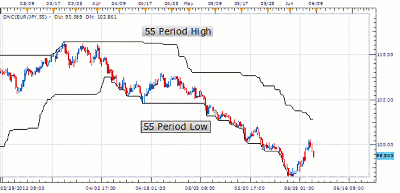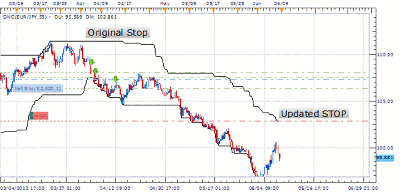Donchian channels can help currency traders automatically define stop levels for their trades, writes Walker England, instructor for DailyFX.com, providing a trade example that proves their effectiveness.
When placing a trade in the market, professional traders always include a plan for managing their risk. One traditional method for setting risk levels is through the use of technical indicators.
In previous articles, we discussed using average true range (ATR) and the parabolic stop and reverse (PSAR) indicator exactly for this purpose. Today, we will examine another method of trailing stops using a custom pricing channel.
Donchian channels (DNC) comprise a custom indicator that can be added to most forex trading platforms and can be used to establish initial and trailing stop levels on a trade. The indicator is designed to display the current high and low for a specified number of periods.
See also: FX Indicator Is Hard to Say, Easy to Trade
Typically, the setting of 55 or 20 periods are used for this purpose. Traders who prefer wider stops should opt for a higher DNC setting, while lower settings offer tighter stop entries.
The chart below depicts the EUR/JPY downtrend developing from the March 2 high at 111.42. Since this point, we have entered three trades using multiple strategies. Regardless of our entry mechanism, one fact remains the same: we need to manage risk!
Primary stops can use the 55-period high depicted with pricing channels as our first point to place our original stop. This level is important, and if a trend begins making higher highs in a downtrend, we would want to exit our position as quickly as possible.
Pricing channels can also be used to lock in profits as a trend develops. As lower highs are made, our top channel will move lower as well in accordance to the new 55-period high. Traders can use this trailing component by manually updating their stop to the current reading of the DNC indicator.
Below, we can see the upper channel residing at 102.86 on the EUR/JPY eight-hour chart. From our initial entry, this would allow our primary trade on the EUR/JPY placed at 108.09 on April 4 to lock in profit of 523 pips. This process can continue until price touches our top pricing channel or an established limit is taken.
Note: Price channels are a custom indicator on some trading platforms. If you are an FXCM customer, they must be loaded into Marketscope 2.0. For a full description on how to add DNC price channels to your graph, please see our download instructions.
On the other hand, you don't want to take your profits too quickly. Does this sound familiar?
"Most of the time I earn a few pips and close out the trade because I want to catch it while it is still profitable. But when the trade goes against me, I will hang on to it too long, thinking it will come back to profitability. But then I get scared and close it out so I don't end up losing more. And then, what's really frustrating is that the currency pair ends up moving back in the direction of my original trade!" How can I learn to stick with my trade?"
This is a great question and it is something with which all traders-especially in the beginning-have a challenge. It is also something that is gained through experience.
NEXT: How to Cut Losses and Let Profits Run
|pagebreak|A key concept that a trader must grasp is to acknowledge that they will have losing trades.
If a trade moves against you, as a trader, you need to be willing to accept the losing trades just as you are willing to accept the winning trades. Moreover, since you are trading with risk capital-money that you can afford to lose-a trader simply must be OK with a loss because it will not affect their lifestyle one tiny bit.
Losses are simply a part of trading. (And by the way, if you are not trading with risk capital, that is, money you can afford to lose, stop trading!)
Once a trader accepts the above concepts, they will be more inclined to let a trade "play out" and not jump at the chance to lock in a tiny bit of profit or become distraught as a trade begins to move against them and close out the position.
Next, be certain that you are taking only the higher-probability trades, those that are in the direction of the trend. And be certain that your entries are based on a solid technical reason such as a break of support or resistance.
When a trader knows that they are trading a pair that is in a strong trend, they will have the courage of their conviction, the confidence to be able to stick with the trade. This does not mean that sticking with a trade in the direction of the trend will insure a winning trade. It does mean, however, that you will be taking trades that have a greater potential for success.
Once you have decided on the higher-probability pair you will trade and know where you will place your initial stop and limit, when the trade executes, leave it alone! Promise yourself that you will only let the trade limit out or be stopped out.
Lastly, be sure that you are following the principles of risk management. That way, when the losing trades occur, as they invariably will, your losses will be small and manageable.
Practice this discipline many, many times in a demo account until you become comfortable with it.
See also: The Best Risk Management Tool You've Never Heard of
By Walker England, instructor, DailyFX.com




















